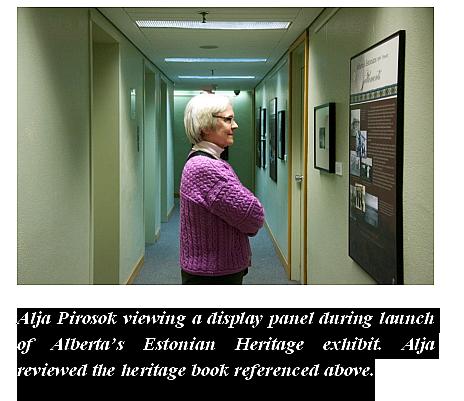Eerik Purje (Translated by Alja Pirosok)
The official launch of the Alberta Estonian Heritage Society’s exhibition Alberta’s Estonians 1899 to Present took place on Saturday, January 19 in the hall at Tartu College (TC). Ain Dave Kiil delivered an introductory presentation, followed by a screening of the 2007 DVD film Alberta’s Estonians.
Dave Kiil during his presentation at launch of “Alberta’s Estonians 1899 to Present” exhibit at Museum of Estonians Abroad (VEMU) in Toronto
The opening ceremony was ushered in with a brief talk by VEMU’s Head Archivist Piret Noorhani, who emphasized that cultural heritage belongs to future generations. She drew attention to the Estonian National Museum as a site of some contention in the homeland. There are those who consider the expenses involved excessive and frivolous. At the same time, we can see that Alberta’s relatively small Estonian community has remained vibrant for over a hundred years. Although its activity is perforce already mainly in English, the interest in one’s roots is as strong as ever, as vividly attested to by the current exhibition. It is apparent that the love for things Estonian there cannot yet be discounted.
In his speech Ain Kiil gave a lively demonstration that there is nothing impossible or odd about a synthesis of the Estonian mind and the English language. He started with his name, explaining how Canadian schoolmates had wrung from the Estonian “Ain” the English “Dave”. Ain accepted the new name, but did not wish to forego the old, so he became Ain Dave. Depending on the social group, he uses one or the other first name, officially both. He speaks flawless Estonian but acknowledges that it no longer flows as freely as he would like. He presented his talk in English, which was just as well since that fit in better with both the project of the exhibition and the film.
With the aid of slides Ain introduced a five-part project, the final result of which has presently reached the TC lobby and corridor walls. He spoke of Estonianhood in the province of Alberta as one of the oldest and most unique, in that the first residents were true pioneers. The early pioneers came largely from the Võru region and several Estonian settlements in Russia, beginning in 1899. Others emigrated from Estonia to Crimea, and had left there for the United States when the Czarist regime began to draft youth into the Russian army. From there they migrated on to Canada, where the government made it possible to purchase uncultivated land on favourable terms, in order to settle the province of Alberta. The Estonians were drawn by the primordial desire to be masters on their own plot of land. After the overthrow of the Czarist regime a portion of the emigrants made their way to the newly created Soviet Union. About half of them came back disappointed.
After the Second World War Alberta’s Estonianhood got replenished by fugitives from Soviet power, who arrived from Germany or Sweden. According to the 2006 Canada Census there were about 2,200 people living in Alberta who declared themselves to be of Estonian origin. The Alberta Estonian Heritage Society (AEHS) was established in 2005 with the aim of preserving Estonian culture and traditions. This was necessary because after many generations, through the pull of assimilation, the mother tongue had begun to disappear. The Estonian language now predominates in only a few families. The Society has about a hundred active members who are scattered across the whole province. Two to three hundred gather for larger events. The periodical Ajakaja is published in English. Besides the film, another publication is the attractive and informative book Freedom, Land & Legacy: Alberta’s Estonians 1899-2009, which has been reviewed in Estonian World Review (see EWR Eestlased Kanadas 05 Jan 2013) and Estonian Life (see EL # 2, January 11 2013).
Alja Pirosok viewing a display panel during launch of Alberta’s Estonian Heritage exhibit. Alja reviewed the heritage book referenced above.
The film presentation, captivating in its comprehensiveness and professionalism, gives an excellent picture of the early days of Alberta’s Estonian community and of its later development. There are commentaries by leading figures in the Society, such as Dave Kiil and Eda McClung (both editors of Ajakaja, who grew up in the Second World War exile community); also the Society’s president Bob
Kingsep, who does not himself speak Estonian, but whose grandfather was the first Estonian pioneer to settle in Alberta in 1899. The film ends with a spirited Estonian sing-along, in which everyone takes to the woods, not just you and me, but two “bear hunters” too.
Those present thanked Ain Kiil with a hearty round of applause, to which Piret Noorhani added a plum on her part – the selection of autographs she has compiled from the Estonian Cultural History Archives titled “The Hand that Writes”. After that it was on to savouring the traditional coffee and kringel and admiring the displays in the exhibition.

